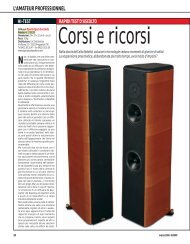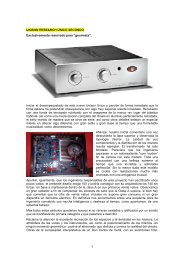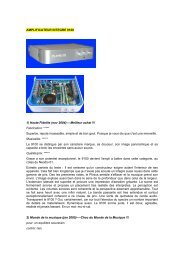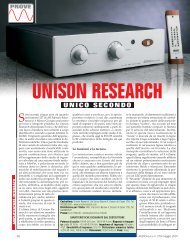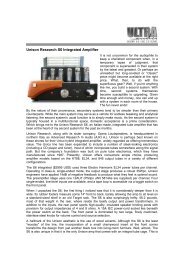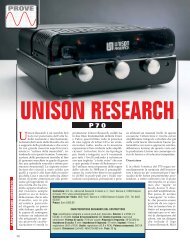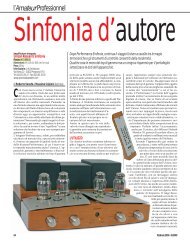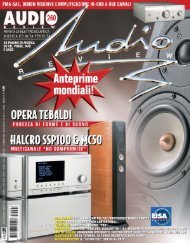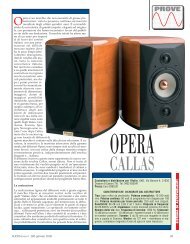UNISON RESEARCH S6 The Unison Research S6 - Lyric Audio Elite
UNISON RESEARCH S6 The Unison Research S6 - Lyric Audio Elite
UNISON RESEARCH S6 The Unison Research S6 - Lyric Audio Elite
- No tags were found...
You also want an ePaper? Increase the reach of your titles
YUMPU automatically turns print PDFs into web optimized ePapers that Google loves.
<strong>UNISON</strong> <strong>RESEARCH</strong> <strong>S6</strong><strong>The</strong> <strong>Unison</strong> <strong>Research</strong> <strong>S6</strong>Uses Single 'Ended operation, which eliminates crossover distortion, so it really is quite a lotdifferent from the norm. - and pure Class A. <strong>Unison</strong> keep size down to manageable proportions,especially considering that there's no less than 28watts per channel from three EL34s workingin parallel per side.<strong>The</strong> amplifier is monstrously heavy, because the output transformers must contain plenty ofiron!<strong>The</strong> output val ves and input double triodes lie under a neat, hinged grill. On the front panel area volume control and input selector; the power switch is on the rear. <strong>The</strong> case is comparativelynarrow, but deep.<strong>The</strong>re are four inputs, all at line level, plus a tape in/oUt with accompanying monitor switch.Unlike the Soro, If you want to use LP then an external pre-amp will be needed. valve or solidstate.Outputs are provided for 40hm and 80hm loudspeakers and, nowadays, even in the UK itis wisest to use the 40hm tap,since most - if not all loudspeakers use 40hm bass units.<strong>The</strong> <strong>S6</strong> is a sonic step up from the <strong>Audio</strong>note Soro SE, It's actually a pretty close rival to the<strong>Audio</strong> <strong>Research</strong> Vsi55. Whereas the latter: is a big. bruising American powerhouse of anamplifier, the <strong>S6</strong> is ! an altogether more finessed and fragile ltalian exotic.<strong>The</strong> Rachmaninov disc was a revelation. Whereas the Soro gave a different presentation to theA21, the <strong>S6</strong> gave a comprehensively superior one. From the opening bar, it's so open anduncoloured - much in the same way as the Sugden. yet more so.On Mike Oldfield's remastered “Tubular bells part 1”, for the first time I could explicitly hear thefull envelope of the notes from the open ing keyboards, not just the attack but the decay too.<strong>The</strong>re was a lot more detail and clarity, taking me right into the recording. While the A21 a had agood stab at this, it was ultimately just a little looser and more veiled in the midband, but the <strong>S6</strong>seemed relentlessly incisive. It was able to eke out oodles of very subtle detailing, and –importantly- string it together in a brilliantly cohesive way. Its genius was its ability to show therhythmic accents of those keyboard parts. Its dynamic prowess was superb too - startling speedallied to real welly made for a very forceful and emotive performance. It has real bass powerand punch to match its excellent grip.<strong>The</strong> only downside is just a touch of brightness in the midband - and I do mean just a touch.<strong>The</strong> <strong>S6</strong> ' has a 'well lit' upper mid, although it isn't actually bright or forward as such. <strong>The</strong> EL34output valves are probably the cause, since they are known to be a trifle hard. Many willameliorate this with vinyl and sympathetic 'speakers, so I wasn't particularly troubled by it.Overall though, the 56 is superb and something I for one would love to live with.If anyone tells you that valve amplifiers are necessarily 'warm', 'woolly', 'rose-tinted' or'coloured', then they obviously haven't heard this little lot. Here is conclusive proof that tUbescan sound just as different as transistors - in fact, I'd say the differences between the <strong>Audio</strong>note
Soro and the Graaf GM20 are easily greater than, say, Sugden's A21 a and Arcam's FMJ A32.<strong>The</strong> fact is that whether an amplifier uses valves or not does not prescribe itS sound. Rather, it'sthe fundamental circuit topology, type of tubes, make of types and the quality of the outputtransformers which determine the sound, and not simply the fact that they glow in the dark andmake a clicking noise when you switch them on or off.AII amplifiers - either solid state or tubular - are compromises. Each one is a particular take onthe eternal price vs. performance dilemma. In the l.1,000 bracket, you have a wealth of choice.<strong>The</strong>re are lots of 'super integrateds' from the likes of Cyrus, Naim, Arcam, Myriad et al, and theSudgen A21 a is probably the most charismatic. It's not the best all rounder at the price, butgiven the fact that you have a smallish room and sensitive loudspeakers, and you valuetransparency and finesse over power and punch, then ¡t's the best you can do. It doesn't soundlike any other tranny amp I've heard, but then again it doesn't sound like any valve amp either -so it's a fascinating foil to the likes of Naim's Nait 5 (on the lean and punchy side) and the<strong>Audio</strong>note Soro SE (on the warm and sweet side).Indeed, the <strong>Audio</strong>note Soro SE is essentially a 'my fírst valve amplifíer' it's a great way in to theworld of glass audio, and has real merit. If you've never heard a tUbe amp before, but haveformed an idea in your mind from anecdotal information, then this is probably the closest you'lIget to how you imagine it.Yes, it really is warm (and all the other clichés at the top of the page).Put simple acoustic music on at relatively low levels and users of even very tasty transistoramplifíer users will be surprised at its wonderfully beguiling and enveloping sound they'lI think,"hang on - why is this so good?" Put thumping, kicking dance music on and it trips over itselfand betrays its budget status, however. <strong>The</strong> trick is to buy it if it suits your music tastes andsystem, but leave well alone if not.Moving to the <strong>Unison</strong> <strong>Research</strong> <strong>S6</strong>, and here you have a reasonably powerful product withexquisite styling and the ability to play any music and make it natural and enjoyable. It's veryengaging, lucid and Iyrical - yet has plenty of punch and grip in the bass, commandingsoundstaging and fine dynamics. It does both the musical stuff and the hi-fí stuff so very wellthat many will wonder why they should ever spend any more... This, allied to its delicious stylingand fine build make it the best value for money in the group by far.<strong>The</strong> <strong>Audio</strong> <strong>Research</strong> is slightly less accomplished in the midband and treble - there's lessincision and finesse- but it still works better overall than the <strong>Unison</strong> <strong>Research</strong> thanks to itstremendous power and scale. As I said last month, it's 'valves without tears' - you get much ofthe excellent liquidity and musicality of the 56, but with wall shaking, flareflapping levels ofpower. It will drive any modern loudspeaker reasonably loudly, and if you have a decent highsensitivity design (as indeed you should), then it will be the life and soul of your party.This leaves the Graaf. For me, it is easily the best here. Take the strengths from both the<strong>Unison</strong> <strong>Research</strong> and the <strong>Audio</strong> <strong>Research</strong> and sum them, then multiply by two. It hastremendous power and articulation, allied to a startlingly clean and clear midband. In a sense, itsounds as stark and 'transparent' as any high resolution transistor design, yet lacks theinevitable 'mush' or 'clang' of solid-state. It is a resounding answer to those who trot out thoseaforementioned valve clichés - sit them in front of this and their jaws will be on the floor! Factorin a quality of finish that would shame an 5ME Series V (yes, really) and the look of thoseincredible 6C3CC triodes glowing away, and it's a stUnning thing to behold. Funnily enough, itSbrilliantly clean and open nature is somewhat reminiscent of 5ugden's A2 la, albeit on a fargrander scale!.VEREDIT:Tremendously musical and lithe sound with real finesse and subtlety toa. Fantastic value.Hi-Fi World & Computer <strong>Audio</strong> (November 2003)



